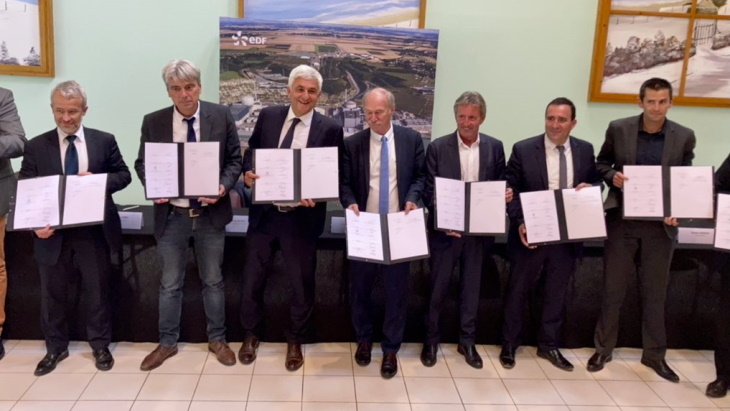Local elected officials from the region around the Penly nuclear power plant in Normandy, northern France, have reiterated their support for the construction of two EPR2 reactors at the site. In a manifesto expressing their support, they say such a project - representing an investment of about EUR15 billion (USD17 billion) - would have a significant positive socio-economic impact on the region.

Elected officials from Normandy following the signing of the manifesto (Image: @Herve_Morin)
EDF has stated that it would like to construct six more EPR reactors in France. The group was due to submit a report to the French President in mid-2021, who will then decide on the construction of the reactors. During a trip to Framatome's Le Creusot plant in December last year, President Emmanuel Macron said the final decision to build new reactors must be taken no later than 2023, when the Flamanville EPR will be in service.
To date, the Normandy (Penly site), Hauts de France (Gravelines site) and Auvergne Rhône-Alpes (several current sites) regions have volunteered to host these projects.
The signing of the new manifesto followed the first plenary meeting of the 'CAP Penly2' Strategic Committee on 20 September. It was signed by Hervé Morin, president of the Normandy Region, and 12 representatives of the territory, including the cities of Dieppe and Tréport.
"We, elected officials, local authorities, entrepreneurs, representatives of civil society, are convinced that the construction of two EPR2 reactors in Penly must be an opportunity for our future," the manifesto states. "We are committed to adopting an open, vigilant and constructive stance in order to ensure that the interests of the territory are taken into account, from the consultation phase and in the long term."
The Normandy Region said in a statement: "At the initiative of the region, all the political and economic actors of the Dieppe basin are mobilising to support the construction project of two EPR2 reactors on the Penly nuclear site and are putting themselves in working order to support and facilitate their installation."
In December 2018, unit 1 of the Taishan plant in China's Guangdong province became the first EPR to enter commercial operation. Taishan 2 began commercial operation in September 2019. Construction of the Olkiluoto 3 EPR in Finland began in 2005, with completion of the reactor originally scheduled for 2009. However, with various delays and setbacks, fuel loading is now planned for later this year. The loading of fuel into the Flamanville EPR in France, construction of which began in December 2007, is now scheduled for the end of 2022. Two EPR units are also under construction at the Hinkley Point C project in Somerset, England.
EDF and Framatome are developing a simplified version of the EPR design, known as EPR2. Its aim is to incorporate design, construction and commissioning experience feedback from the EPR reactor, as well as operating experience from the nuclear reactors currently in service. EDF must ensure the financing and profitability of its proposed EPR2 reactor before starting construction of any plants based on the design in France, the country's state audit office has said.
According to the French nuclear energy society (SFEN), an EPR project creates 8350 jobs in the construction phase and 1600 other positions continuously over the 60-year operating life of a unit. Investment in the nuclear power industry has a positive impact on SMEs and 'mid-cap' companies, which also work for other major industrial sectors, and produces a total cumulative turnover of around EUR47.5 billion, it added.
"The launch of a programme to build new nuclear reactors would be an effective tool for economic and social recovery from 2021," SFEN wrote in a May 2020 position paper, adding that the nuclear industry is "ready to mobilise" as part of that effort.
Researched and written by World Nuclear News